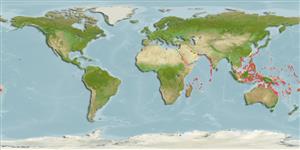>
Gobiiformes (Gobies) >
Gobiidae (Gobies) > Gobiinae
Etymology: Paragobiodon: Greek, para = the side of + Latin, gobius = gudgeon + Greek,odous =teeth (Ref. 45335).
More on author: Regan.
Environment: milieu / climate zone / depth range / distribution range
Ökologie
seewasser riff-verbunden; tiefenbereich 3 - 15 m (Ref. 90102). Tropical; 30°N - 32°S
Indo-Pacific: East Africa to Marshall Islands, north to the Ryukyu Islands, south to eastern Australia (Ref. 33390).
Size / Gewicht / Alter
Maturity: Lm ? range ? - ? cm
Max length : 3.5 cm TL Männchen/unbestimmt; (Ref. 2798)
Rückenflossenstacheln (insgesamt) : 7; Rückenflossenweichstrahlen (insgesamt) : 8 - 9; Afterflossenstacheln: 1; Afterflossenweichstrahlen: 9 - 10. Color pattern similar to P. echinocephalus (i.e. reddish orange head an black body and fins), but has shorter papillae on head. Midline of belly naked (Ref. 1602). Transverse scales 10-11. Mouth strongly curved downward; lips thick; chin heavy and square. Entire nape naked. Opercles with short, soft prickles or fibrils which also occur from lower margin of preopercles to mouth; ventrals also covered with similar prickles; dorsal fins very close together; dorsal base discontinuous; 2nd dorsal higher than 1st, posterior rays elongated; anal similar to 2nd dorsal but lower; caudal rounded; pectoral broad (Ref. 43541); characterized further by: longitudinal scale series 22-24; scales ctenoid except head, nape, pectoral region, breast and midventral portion of abdomen; complete pelvic fin frenum and basal membrane; depth of body at level of pelvic fins 3.0-3.4 in SL (Ref. 90102).
Occurs among the branches of live Pocillopora, in lagoons to a depth of at least 7 m (Ref. 1602). Also found among branches of Seriatopora corals in 3-15 m (Ref 90102).
Life cycle and mating behavior
Geschlechtsreife | Fortpflanzung | Ablaichen | Eier | Fecundity | Larven
Randall, J.E. and M. Goren, 1993. A review of the gobioid fishes of the Maldives. Ichthyol. Bull. J.L.B. Smith Inst. Ichthyol. (58):1-37, 5 pls. (Ref. 9360)
IUCN Rote Liste Status (Ref. 130435: Version 2024-2)
Bedrohung für Menschen
Harmless
Nutzung durch Menschen
Tools
Zusatzinformationen
Download XML
Internet Quellen
Estimates based on models
Preferred temperature (Ref.
123201): 25 - 29.3, mean 28.3 °C (based on 2008 cells).
Phylogenetic diversity index (Ref.
82804): PD
50 = 0.5156 [Uniqueness, from 0.5 = low to 2.0 = high].
Bayesian length-weight: a=0.01995 (0.00906 - 0.04395), b=3.01 (2.83 - 3.19), in cm total length, based on all LWR estimates for this body shape (Ref.
93245).
Trophic level (Ref.
69278): 3.1 ±0.3 se; based on size and trophs of closest relatives
Widerstandsfähigkeit (Ref.
120179): hoch, Verdopplung der Population dauert weniger als 15 Monate. (Preliminary K or Fecundity.).
Fishing Vulnerability (Ref.
59153): Low vulnerability (10 of 100).
Nutrients (Ref.
124155): Calcium = 302 [122, 696] mg/100g; Iron = 1.35 [0.63, 2.95] mg/100g; Protein = 17.8 [15.7, 19.7] %; Omega3 = 0.12 [0.04, 0.29] g/100g; Selenium = 27.2 [10.0, 64.4] μg/100g; VitaminA = 77.5 [16.5, 352.4] μg/100g; Zinc = 3.02 [1.76, 4.98] mg/100g (wet weight);
